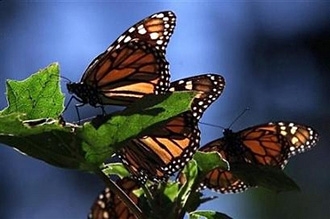 |
 |
 |
 Editorials | Environmental | August 2007 Editorials | Environmental | August 2007  
Perfect Mexican Winter Fuels Monarch's King-Sized Canadian Comeback
 Graham Hughes & Ciara Byrne - The Ottawa Citizen Graham Hughes & Ciara Byrne - The Ottawa Citizen
go to original


| | Canadians who were used to seeing fewer and fewer of the gorgeous insects are suddenly seeing as many as they ever have. |
It's not your imagination: there are more monarch butterflies flitting around Canada this summer.

In fact, the large, brilliant orange and black butterflies are present in numbers seen only once in a decade, or more, says Ross Layberry, co-author of the book The Butterflies of Canada.

Mr. Layberry said yesterday it's not only our area that is enjoying a surfeit of monarchs.

"I've been getting reports of unusually large numbers from Newfoundland to British Columbia," he said, adding that they are usually more common from Manitoba east, than in Saskatchewan, Alberta or B.C.

"You can't go anywhere in the area without seeing monarchs drifting by," said Don Lafontaine, a research scientist at Agriculture Canada, and another of the authors of Butterflies.

The population varies by a factor of 10, year to year, he said, and this year's bumper crop is no guarantee of how many we'll see next summer.

Both men said it took a number of favourable conditions to give us our visual treat.

"It depends on the kind of winter they get in Mexico and the kind of weather and winds they get when they're heading north," Mr. Layberry said.

"If they got nice strong southwesterly winds, which is probably what happened this year, most of them likely make it north."

But it's not only strong winds that helps steer the butterflies northward, according to David Phillips, a senior climatologist at Environment Canada.

"It depends on their wintering conditions and their route south. If the conditions are ideal, mortality is lower," said Mr. Phillips, who said there was a warm spring and summer in Mexico. He also said there were no arctic blasts during the butterflies' migration.

Mr. Lafontaine said those butterflies that over-winter in the mountains of Mexico move north to the Gulf coast and Texas to breed on milkweed in early spring, and that's the generation that flies to the northern U.S. and Canada.

"So, if it's a good spring for milkweed and for growing monarchs in March, April and May in the Gulf coast, then large numbers come north," he said. "If they're having bad weather or droughts, then they don't do well."

He said that while lumbering has reduced their environment in Mexico and have put them on some endangered lists, they face a greater threat from the ice storms that can hit the forested areas where they wait out the northern winter.

There have also been more butterflies in the southern United States, which means more have reached the Ottawa area this season.

As well, "we've had perfect growing weather all summer with the plants nice and green, moist and good to eat."

Mr. Layberry said monarchs are even laying eggs on the swamp milkweed in the beaver pond behind his house.

"Generally, they don't feed on it, but in good years like this, there's caterpillars on the swamp milkweed," he said.

We don't get monarchs every year -- maybe five out of six -- Mr. Lafontaine said.

"Sometimes they come earlier, sometimes later. This year they came in early and came in numbers," he said.

"Since they breed here, and produce several generations, if they get here earlier we see more because they produce several generations."

The monarch population will peak in late August, he said, because that is the generation emerging that heads south.

"I would say there are many times more than normal. We have good years and bad years over a 10-year span," Mr. Lafontaine said.

"We're probably seeing five times as many monarchs as we would see normally."

"Even people who usually don't see them are seeing them this year and are commenting on them." | 
 | |
 |



